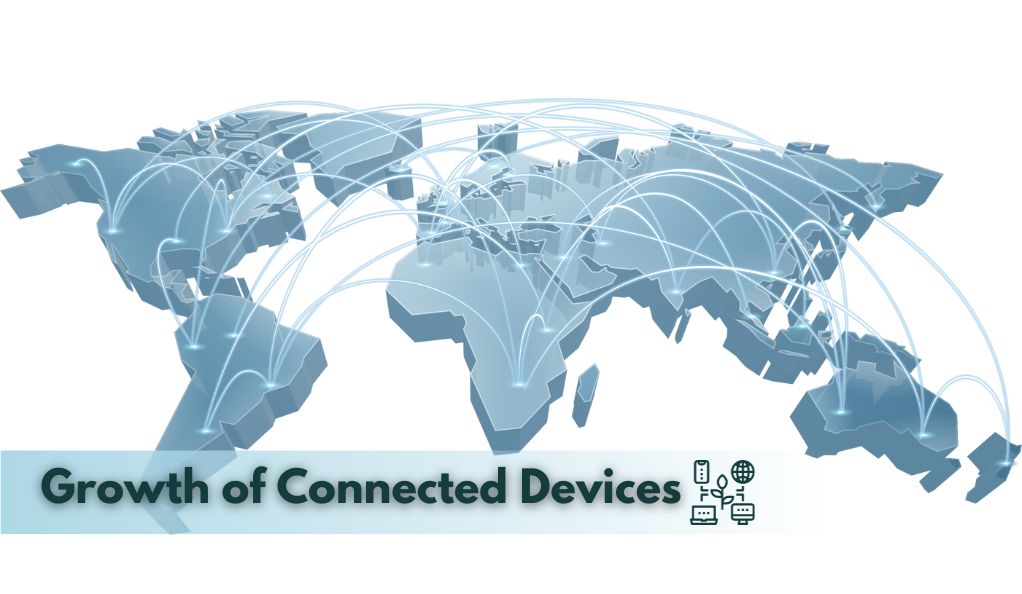The Internet of Things (IoT) is a transformative concept that has reshaped the way we interact with the world around us. At its core, IoT refers to the network of physical objects embedded with sensors, software, and other technologies to connect and exchange data with other devices and systems over the internet. These “things” can range from everyday household items like refrigerators and thermostats to complex industrial machinery.
The Exponential Growth of Connected Devices

In the past decade, the number of connected devices has skyrocketed. According to Gartner, there will be over 25 billion connected devices by 2025. This explosive growth can be attributed to several factors:
- Decreasing Costs: The cost of sensors and connectivity has decreased significantly, making it economically viable to add these components to a wide range of products.
- Technological Advancements: Improvements in battery life, data processing capabilities, and wireless communication technologies have paved the way for more sophisticated and reliable IoT devices.
- Consumer Demand: As consumers become more tech-savvy, there’s a growing demand for smart devices that offer convenience, efficiency, and enhanced user experiences.
| Year | Estimated Number of Connected Devices (in billions) |
|---|---|
| 2015 | 4.9 |
| 2020 | 12.1 |
| 2025 | 25.4 |
The Potential and Promise of the Internet of Things
The potential applications of IoT are vast and varied. From smart homes that adjust the temperature based on your preferences to industrial IoT (IIoT) systems that monitor machinery for signs of wear and tear, the possibilities are endless. Here are a few areas where IoT is making a significant impact:
- Healthcare: Wearable devices monitor vital signs in real-time, alerting medical professionals to potential health issues.
- Agriculture: Smart farming solutions use sensors to monitor soil moisture levels, optimizing irrigation and reducing water waste.
- Transportation: Connected vehicles can communicate with each other to prevent accidents and optimize traffic flow.
- Retail: Smart shelves in stores can detect when stock is low and automatically reorder products.
The rapid development of IoT technology is not without its challenges, especially in the realm of security. As we connect more devices and share more data, the potential vulnerabilities increase.
The Security Concerns in IoT
As the realm of IoT expands, so does the complexity of ensuring its security. The vast network of interconnected devices presents a unique set of challenges, distinct from traditional IT security concerns. While the benefits of IoT are undeniable, the potential risks cannot be overlooked.
Similarities with Conventional Servers and Devices
At a foundational level, many IoT devices operate similarly to traditional computing devices. They have operating systems, run software applications, and communicate over networks. As such, they are susceptible to many of the same threats:
- Malware and Viruses: Just as computers can be infected, IoT devices can also be targeted by malicious software designed to hijack, damage, or steal information.
- Phishing and Spoofing: Devices can be tricked into connecting to malicious networks or accepting data from untrustworthy sources.
- Unauthorized Access: Weak passwords or unsecured networks can allow hackers to gain control of devices.
Unique Challenges Posed by IoT Device Limitations
However, the nature of IoT introduces additional challenges that are less common in conventional IT:
- Diverse Device Landscape: Unlike the standardized world of PCs and smartphones, IoT encompasses a vast range of devices, from smart light bulbs to industrial sensors. This diversity makes it challenging to develop universal security protocols.
- Limited Processing Power: Many IoT devices are designed to be cost-effective and energy-efficient, which often means they lack the processing power to run advanced security software.
- Long Device Lifespans: While we might replace our smartphones every few years, an IoT-enabled refrigerator or factory machine might be in use for a decade or more. Over such long lifespans, security vulnerabilities can emerge, and outdated devices may not receive necessary updates.
- Physical Accessibility: Many IoT devices are physically accessible. A malicious actor could tamper with a public-facing device, like a security camera or a smart meter, introducing vulnerabilities.
The Growing Threat Landscape
With the proliferation of IoT devices, the potential attack surface for cybercriminals has expanded dramatically. A compromised IoT device can serve as a gateway to a larger network, allowing hackers to access sensitive data or disrupt operations. For instance, a hacked smart thermostat could provide access to a home’s entire network, compromising personal data and security.
Moreover, the stakes are higher than ever. In sectors like healthcare or transportation, a security breach could have life-threatening consequences. Imagine the ramifications of a hacked insulin pump or a compromised car braking system.
The Role of Machine Learning in Enhancing IoT Security

Machine Learning (ML), a subset of artificial intelligence, has emerged as a game-changer in the realm of IoT security. By analyzing vast amounts of data and recognizing patterns, ML algorithms can predict, detect, and respond to potential threats in real-time, offering a proactive approach to security.
Predictive Analytics for Threat Detection
One of the primary advantages of machine learning is its ability to analyze vast datasets quickly and identify patterns or anomalies. In the context of IoT:
- Behavioral Analysis: ML algorithms can learn the “normal” behavior of an IoT device. Any deviation from this behavior, such as an unexpected data transfer or a sudden change in device settings, can be flagged as a potential threat.
- Trend Prediction: By analyzing historical data, ML can predict potential future threats or vulnerabilities, allowing for preemptive action.
Machine Learning Models for Anomaly Detection
Anomaly detection is crucial in IoT security. Given the diverse range of IoT devices and their varied functionalities, defining what constitutes “normal” behavior can be challenging. Here’s where ML shines:
- Self-learning Models: Over time, ML models can “learn” the typical patterns of each device, adjusting their baseline understanding and becoming more accurate in detecting anomalies.
- Real-time Analysis: Machine learning models can process data in real-time, ensuring that threats are detected and addressed immediately.
Automated Response Systems
Beyond detection, ML can also aid in the immediate response to threats:
- Quarantine Protocols: If an IoT device is behaving suspiciously, ML algorithms can automatically isolate it from the network, preventing potential spread of malware or data breaches.
- Notification Systems: Stakeholders can be instantly alerted about potential threats, ensuring swift human intervention when necessary.
Challenges and Considerations
While ML offers promising solutions, it’s not without challenges:
- Data Privacy: The very nature of ML requires access to vast amounts of data. Ensuring this data is handled securely and ethically is paramount.
- Model Accuracy: False positives or negatives can have significant consequences. Continuous training and model refinement are essential to maintain accuracy.
- Resource Constraints: Running advanced ML models requires computational power. Ensuring IoT devices can support these operations without compromising performance is a balancing act.
Fault Injection Attacks: A New Threat Landscape

In the evolving domain of cybersecurity, fault injection attacks have emerged as a novel threat, particularly concerning the Internet of Things (IoT). Unlike traditional cyber threats that primarily target software vulnerabilities, fault injection attacks focus on the hardware components of devices. By introducing errors into a device’s hardware operations, attackers can induce unintended behaviors, potentially bypassing established security measures.
The mechanics of fault injection can be understood through various methods employed by attackers:
| Method | Description |
|---|---|
| Voltage Glitching | Attackers cause sudden drops or spikes in the device’s power supply, forcing it into a faulty state. |
| Clock Glitching | The device’s internal clock is tampered with, disrupting its regular operations. |
| Laser Attacks | Directing laser beams at specific device components can induce faults, altering device functionality. |
Given the potential ramifications of such attacks on IoT devices, from data breaches to device malfunctions, it’s crucial to implement measures that can counteract these threats. One approach is to introduce hardware redundancy. By having multiple hardware components performing the same function, devices can cross-check operations, ensuring consistency and reliability. Real-time monitoring, using sensors to track voltage, clock speed, and temperature, can also help in early detection of fault injection attempts. Additionally, for devices that are particularly at risk, physical barriers, such as metal shields, can be employed to deter direct tampering or laser-based interventions.
Case Study: The Mirai Botnet Attack
In September 2016, the digital world witnessed the ramifications of the Mirai Botnet Attack, a stark reminder of the vulnerabilities inherent in the rapidly expanding IoT landscape. The attack’s genesis was rooted in the exploitation of IoT devices. The Mirai malware primarily targeted devices like IP cameras, routers, and digital recorders, especially those with default or weak security configurations. By harnessing the power of these compromised devices, attackers orchestrated a massive Distributed Denial of Service (DDoS) attack, temporarily crippling major online platforms.
The aftermath of the Mirai attack brought to light several critical lessons. Foremost was the realization of the importance of basic security measures. Simple actions, such as changing default credentials and regularly updating device firmware, could have mitigated the risks. The attack also underscored the need for manufacturers to prioritize security in their designs and for consumers to be more vigilant about their devices’ security settings. As the IoT ecosystem continues to grow, such incidents emphasize the collective responsibility of manufacturers, developers, and users to ensure a secure digital environment.
Future of IoT Security with Machine Learning
The future of IoT security, when intertwined with the capabilities of Machine Learning, presents a captivating vision of the next decade. As we anticipate the advancements that lie ahead, certain predictions emerge. We foresee security systems that are not only more adaptive but also capable of learning from past incidents, continuously updating their defense mechanisms in real-time. The role of Machine Learning will be paramount in enabling systems to predict and counteract threats even before they materialize, ensuring a proactive approach to security.
Furthermore, as we gaze upon the horizon, several innovations promise to enhance the security landscape. The advent of quantum computing is set to bolster encryption methods, making traditional hacking attempts nearly obsolete. The decentralized nature of blockchain technology offers a transparent and tamper-proof method of recording data, presenting an attractive solution for IoT security. Additionally, the shift towards edge computing, where data processing occurs closer to the source, promises to reduce risks associated with data transmission. As we navigate this evolving landscape, the fusion of these innovations with Machine Learning will be instrumental in shaping a secure and resilient IoT ecosystem.
Conclusion
The fusion of IoT and Machine Learning heralds a transformative era, promising a world where devices not only connect but also think, learn, and adapt. This synergy offers boundless possibilities, from smart homes that intuitively cater to our needs to industrial systems that self-optimize. However, this interconnected landscape also presents a vast terrain for potential security threats. Every new device is a potential gateway for malicious intrusions, and incidents like the Mirai Botnet Attack serve as stark reminders of the vulnerabilities inherent in this digital tapestry.
As we stride into this promising future, it’s imperative to balance innovation with caution. The onus is on manufacturers, developers, security experts, and end-users to collaboratively forge a secure and cohesive IoT ecosystem. Embracing cutting-edge solutions, establishing industry-wide standards, and prioritizing continuous research and education are pivotal. In this journey of progress, ensuring the safety and trust of users remains our paramount responsibility, guiding us towards a harmonious, intelligent, and interconnected world.








